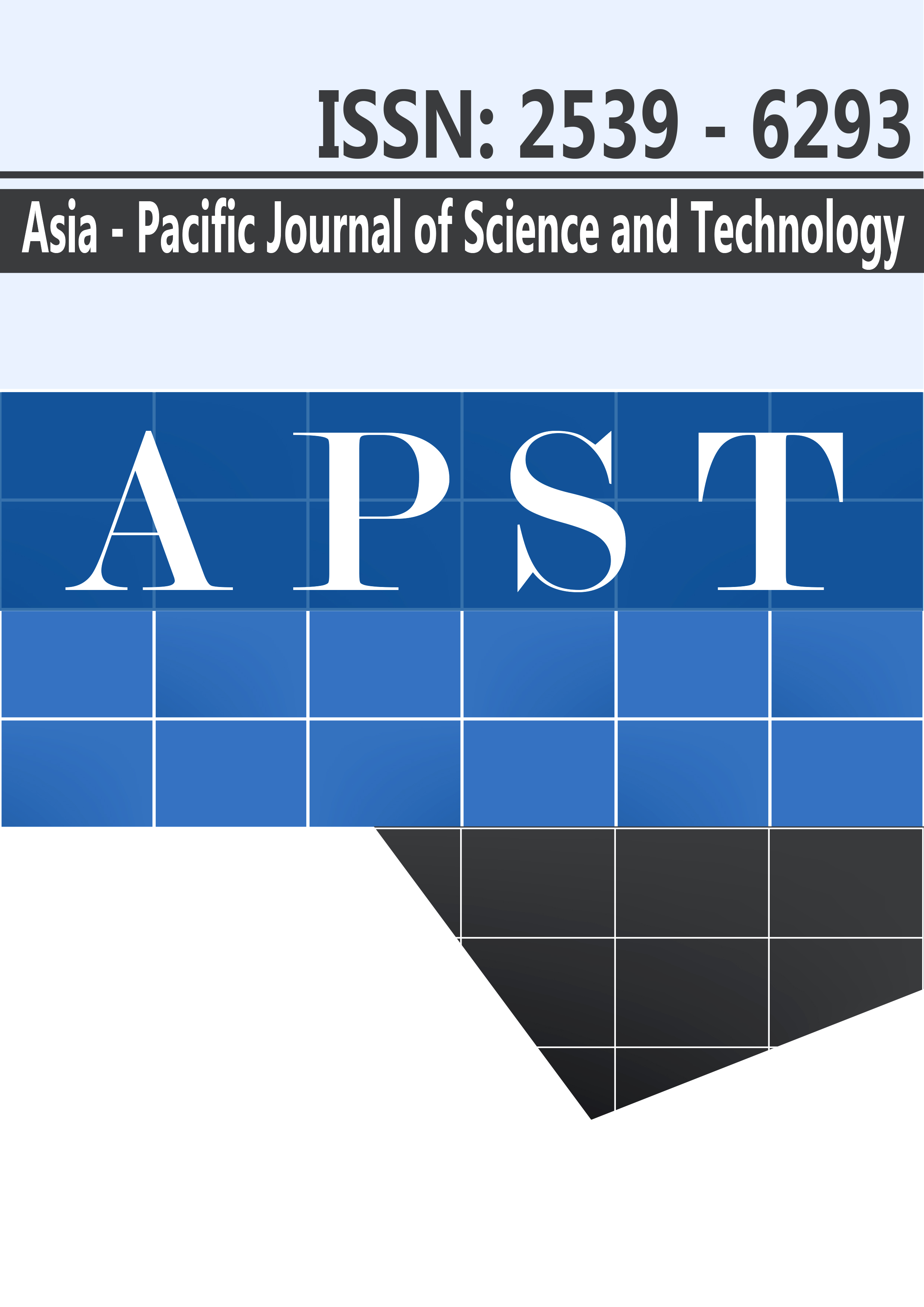Effects of organic coconut flower syrup on glucose and insulin responses and substrate utilization
Main Article Content
Abstract
The glycaemic index (GI) and insulinemic index (II) classify foods on the basis of the blood glucose and insulin concentrations they produce, which are then associated with risk of metabolic diseases. Thus, a database indicating the GI of different foods is necessary for providing people with health information. Nowadays, consumption of the natural product organic coconut flower syrup (OCFS) is increasing. However, there has been no research investigating the GI and II of OCFS. Therefore, this study aimed to measure the GI and II of OCFS and its effect on substrate utilization in healthy subjects between 20 and 40 years of age. The GI and II were calculated from the Area Under Curve (AUC) of plasma glucose and insulin concentrations before and after ingestion of OCFS. Expired air was collected for analysis of substrate utilization 5 minutes prior to and 60 and 120 min subsequent to ingestion. Results showed that the GI of OCFS, OCFS mixed with 1.5% inulin, and OCFS mixed with 3% inulin was 51, 48, and 45, respectively. The II of all OCFS types was low, with the lowest II value belonging to OCFS mixed with 3% inulin. There were no significant differences in substrate utilization within and between food types. These results suggest that the GI and II of OCFS are low, and OCFS is a proper choice of sweetener to replace sugar, an important finding for preventing and decreasing risk of type 2 diabetes mellitus and metabolic diseases.
Article Details
References
(1) Jenkins DJ, Wolever TM, Taylor RH, Barker H, Fielden H, Baldwin JM, et al. Glycemic index of foods: a physiological basis for carbohydrate exchange. Am J Clin Nutr. 1981; 34(3): 362-6.
(2) Henry CJ, Lightowler HJ, Strik CM, Renton H, Hails S. Glycaemic index and glycaemic load values of commercially available products in the UK. Br J Nutr. 2005; 94(6): 922-30.
(3) Food and Agriculture Organization/World Health Organization. Carbohydrates in Human Nutrition. Report of a Joint FAO/WHO Expert Consultation. Rome: FAO; 1998.
(4) Chiu CJ, Taylor A. Dietary hyperglycemia, glycemic index and metabolic retinal diseases. Prog Retin Eye Res. 2011; 30(1): 18-53.
(5) Wolfe RR. Metabolic interactions between glucose and fatty acids in humans. Am J Clin Nutr. 1998; 67: 519Se26S.
(6) Sidossis LS, Stuart CA, Shulman GI, Lopaschuk GD, Wolfe RR. Glucose plus insulin regulate fat oxidation by controlling the rate of fatty acid entry into the mitochondria. J Clin Invest. 1996; 98: 2244e50.
(7) Ludwig DS. Diet and development of the insulin resistance syndrome. Asia Pac J Clin Nutr. 2003; 12 Suppl: S4.
(8) Bagry HS, Raghavendran S, Carli F. Metabolic syndrome and insulin resistance: perioperative considerations. Anesthesiology. 2008; 108(3): 506-23.
(9) Giovannucci E. Metabolic syndrome, hyperinsulinemia, and colon cancer: a review. Am J Clin Nutr. 2007; 86(3): S836-42.
(10) Huffman KM, Orenduff MC, Samsa GP, Houmard JA, Kraus WE, Bales CW. Dietary carbohydrate intake and high-sensitivity C-reactive protein in at-risk women and men. Am Heart J. 2007; 154(5): 962-8.
(11) Kurth T, Moore SC, Gaziano JM, Kase CS, Stampfer MJ, Berger K, et al. Healthy lifestyle and the risk of stroke in women. Arch Intern Med. 2006; 166(13): 1403-9.
(12) Du H, van der A DL, van Bakel MM, van der Kallen CJ, Blaak EE, van Greevenbroek MM, et al. Glycemic index and glycemic load in relation to food and nutrient intake and metabolic risk factors in a Dutch population. Am J Clin Nutr. 2008; 87(3): 655-61.
(13) Bosetti C, Gallus S, Trichopoulou A, Talamini R, Franceschi S, Negri E, et al. Influence of the Mediterranean diet on the risk of cancers of the upper aerodigestive tract. Cancer Epidemiol Biomarkers Prev. 2003; 12(10): 1091-4.
(14) Kahlhöfer J, Lagerpusch M, Enderle J, Eggeling B, Braun W, Pape D, et al. Carbohydrate intake and glycemic index affect substrate oxidation during a controlled weight cycle in healthy men. Eur J Clin Nutr. 2014; 68(9): 1060-6.
(15) Shoaib M, Shehzad A, Omar M, Rakha A, Raza H, Sharif HR, et al. Inulin: Properties, health benefits and food applications. Carbohydr Polym. 2016; 147: 444-54.
(16) Ray KS, Singhania PR. Glycemic and insulinemic responses to carbohydrate rich whole foods. J Food Sci Technol. 2014; 51(2): 347-5.
(17) Holt SH, Miller JC, Petocz P. An insulin index of foods: the insulin demand generated by 1000-kJ portions of common foods. Am J Clin Nutr. 1997; 66(5): 1264-76.
(18) Péronnet F, Massicotte D. Table of nonprotein respiratory quotient: an update. Can J Sport Sci. 1991; 16(1): 23-9.
(19) Eleazu CO. The concept of low glycemic index and glycemic load foods as panacea for type 2 diabetes mellitus; prospects, challenges and solutions. Afr Health Sci. 2016; 16(2): 468-79.
(20) Nishimune T, Yakushiji T, Sumimoto T, Taguchi S, Konishi Y, Nakahara S, et al. Glycemic response and fiber content of some foods. Am J Clin Nutr. 1991; 54(2):
-9.
(21) Leeds AR. Dietary fibre: mechanisms of action. Int J Obes. 1987; 11:3-7.
(22) Leeds AR. Gastric emptying, fibre, and absorption. Lancet. 1979; 1(8121): 872-3.
(23) Dunaif G, Schneeman BO. The effect of dietary fiber on human pancreatic enzyme activity in vitro. Am J Clin Nutr. 1981; 34(6): 1034-5.
(24) Barkoukis H, Marchetti CM, Nolan B, Sistrun SN, Krishnan RK, Kirwan JP. A high glycemic meal suppresses the postprandial leptin response in normal healthy adults. Ann Nutr Metab. 2007; 51(6): 512-8.
(25) Firdous S. Correlation of CRP, fasting serum triglycerides and obesity as cardiovascular risk factors. J Coll Physicians Surg Pak. 2014 May; 24(5): 308-13.


